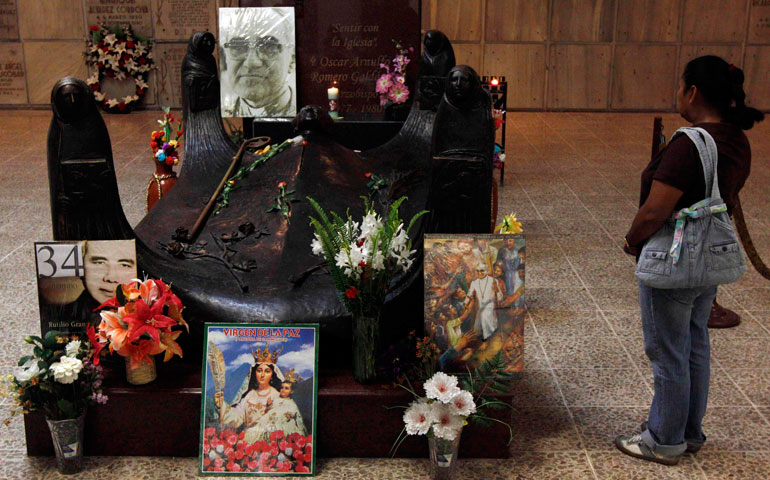
A tourist visits the tomb of Archbishop Oscar Romero in San Salvador in 2011. (CNS/Reuters/Luis Galdamez)
When Archbishop Vincenzo Paglia, promoter for the cause for the beatification of Archbishop Oscar Romero of San Salvador, El Salvador, announced April 20 that the process had been "unblocked" -- seemingly by the approval of Pope Francis -- shock waves of joy surged throughout Latin America and many parts of the global church.
Romero's assassination while saying Mass on March 24, 1980, had by popular acclamation declared him a good shepherd who had laid down his life for the flock during a time of violent repression in the tiny Central American country. His leadership during the years leading up to a 12-year civil war that claimed 80,000 lives also propelled his reputation worldwide as a model for church advocacy for the poor.
In the intervening years, Romero's case for sainthood has successfully passed each level of scrutiny to confirm his orthodoxy and loyalty to the church. No miracle is required for his canonization, because he was martyred, something Pope John Paul II affirmed at a millennial jubilee ceremony in Rome in 2000 when he personally added Romero's name to a list of 20th-century martyrs. A special prayer praised the "unforgettable Oscar Romero, murdered at the altar." Pope Benedict XVI has also acknowledged Romero as a martyr for the faith. Yet the process remained stalled.
Thirty-three years after Romero's death, as anniversaries have come and gone and expectations been raised and dashed, focus has shifted to the question of why it has taken so long to beatify him. Even after the latest flurry of reports, San Salvador Archbishop José Luis Escobar Alas recently said no formal word has yet come from Rome.
In 2010, when anticipation was high ahead of the 30th anniversary of Romero's death, Escobar explained the stalled beatification as the result of efforts by some to "manipulate, politicize or use Romero's image," thus obscuring his largely spiritual role. The message was clear: Romero, while publicly proclaimed as a martyr and prophet, had to be free of all controversy for his path to sainthood to advance.
The taint of "liberation theology," labeled by its critics as an ideologically driven push to overthrow governments, by violence if necessary, has been a tangled thread running through the church since the regional meeting of bishops in Medellín, Colombia, in 1968. That meeting produced the now-famous phrase, "God's option for the poor," and affirmed a different way of doing theology in the developing world.
For perspective, the words of the late Jesuit Fr. Dean Brackley may shed some light on the long wait to acknowledge formally what a whole continent has already proclaimed. Brackley, who died of pancreatic cancer in 2011, went to El Salvador in 1990 to help replace murdered faculty and others on the campus of the Jesuits' Central American University at the height of the civil war. In 2010, he told NCR: "One has to suspect that if Romero were not a bishop, he might have had an easier road to canonization. Because not everyone in the Catholic hierarchy is comfortable with presenting him as a bishop to be imitated."
Romero modeled the church of the poor for Latin America, Brackley said, but "the message is universally valid. The church will only be a bearer of credible hope for humanity if it stands with the poor, with all who are victims of sin, injustice and violence. If we walk with them, as Romero did, we will embody the good news that the world so longs for."
Three years later, under a new pope, the shocking nature of Romero's death and the stunning implications of his example have made his canonization even more relevant for the universal church. What the bishops at Medellín 45 years ago called the "institutionalized violence" of poverty remains the fate of billions of people in the world, and this continues to pose the question Francis is now echoing: "Does the church walk with the poor?"
That is what Romero did, Brackley said, "inspiring countless others to collaborate with him. This will invite persecution and misunderstanding, but that is the fifth mark of the true church. Romero sought not what was best for the institution as such, but what was best for the people. In the long run, that is what is best for the church, too. The institution that strives to save itself will lose itself. If it loses itself in loving service, it will save itself."
[Pat Marrin is editor of Celebration, NCR's worship resource. Portions of this story are taken from his report on the 30th anniversary of Romero's death in 2010.]


